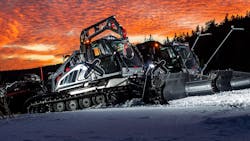For more work truck maintenance:
Even though they might not have wheels, one of the most powerful workhorses on any jobsite is likely to be a crawler carrier. Distinguished by their off-road capabilities and ability to carry heavy loads over tough terrain, crawler carriers can be found in many different environments, from snowy slopes (such as Prinoth’s Alpine Series snow groomers) to muddy work locations (Such as the Prinoth Panther T7R or T14R).
Either way, crawler carriers not only lose their operators money and productivity when they break down, but in the case of some of Prinoth’s Apline equipment, issues brought on by poor maintenance can be even more serious.
“If you don't properly maintain your machines, they could break down on the hill, but with our over-snow machines, they tend to bring people into remote areas far away,” explained Alex Wood, engineering manager for Prinoth. “So you couple that with extreme temperatures, if a machine carrying people were to break down, that [could lead to some] really grave consequences.”
Here's how technicians avoid such circumstances and keep these machines working at peak efficiency, whether traveling over dirt or snow.
Wear and tear
For crawler carriers that operate on snow or soil, the component that tends to see the most wear and tear is, unsurprisingly, where the machine meets the ground.
“The biggest wear item is the tracks,” said Eric Fatyol, product manager for Prinoth crawler carriers. “On tracks, you have places that'll crack and separate from normal wear and tear.”
Snow groomer tracks are the same way, Wood explained, stating that the aluminum or steel cross links of the tracks are particularly prone to wear from snow, ice, and rocks, especially during seasons when there isn’t as much snow. For both snow groomers and traditional crawler carriers, their tracks are also vulnerable to improper operation, such as when a driver “zero turns” a machine, or pivots them on their own axis instead of making a more gradual turn.
“You can stretch your belts significantly [that way],” said Ben Listowich, North American Connected Services Coordinator for Prinoth. Not to mention that doing sharp turns on rocky, abrasive ground or in sand will damage the tracks themselves.
“It's like sandpaper on your wearing items,” Fatyol described.
Additionally, beyond the wear and tear on the tracks, snow groomers’ back tiller can also wear out due to their constant use, Wood noted.
Also, while most crawler carriers operate in extreme conditions and for long hours, the cold of mountainous environments makes materials more brittle, Listowich said, and ice and snow can wear on a snow groomer as much as dirt and mud.
“A lot of our machines will be covered in ice and snow, so your hydraulic hoses that are out in the open get a lot of build up on them,” Wood stated. “That ice can pull down on things that you don't really see in the dirt world, because dirt falls off or bundles up.”
Crawler carrier lifespan
Despite the punishment they endure, for both crawler carriers and snow groomers, their workdays tend to be long and consistent.
“They are the big machines that go into a rental fleet,” Fatyol explained. “And when they run, they don’t spend a lot of time idling.”
In general, Prinoth’s crawler carriers can run from 1,200-1,400 hours per year, depending on the application. Meanwhile, snow groomers can run for 16 hours on the slopes.
As a result of all of this hard labor, most fleets measure their machines’ lifespans in hours as opposed to miles.
“Most of the time, people keep these machines five to 6,000 hours,” Fatyol said, before a fleet will return their carrier and get a new one. Meanwhile, the tracks on a crawler carrier can be replaced between 1,200-2,000 hours.
“The track life is a correlation between how good an operator you have and how they take care of the machine,” Fatyol emphasized.
Meanwhile, Wood said that for new snow groomers, they’ll aim to use their machine for 8,000-10,000 hours, or about four to five years at a large ski resort. But, as was the case for crawler carriers, snow groomers can then be used by a secondary or tertiary user as well, but may not see as much use as when it was new. On a more granular level, Wood said that the main drive belts for a snow groomer can last around 4,000 hours, or about two years. Again, how long a snow groomer lasts can be very dependent on how well it’s cared for.
“I'd say, on average, resorts will keep some of their well-maintained equipment into the 15,000-hour mark,” Listowich said. “I've seen cats with over 20,000 hours.”
Inspecting for success
Fatyol, Wood, and Listowich all noted how important it was for fleets to regularly inspect their crawler carriers and snow groomers.
“You could break a track if you're not doing your daily checks on your engine oil,” Fatyol said. “It's just like any other piece of equipment you've got, if you take care of it, it's going to take care of you.”
For crawler carriers, this means inspecting the track system’s tensioning cylinders to make sure they’re not leaking or damaged. Making sure that the sprockets that drive the tracks, as well as the idlers that support them, are in good condition is paramount too, Fatyol added. Otherwise, this increases the risk of detracking a carrier.
“It will happen on anybody's machine, and part of that comes from not watching your sprockets and making sure they're not worn too much,” he stated. “If a sprocket wears down too much, it loses that bite on the track, and then when you go around a corner, you could detrack.”
Technicians will also want to make sure there’s no hose or hydraulic leaks, and that a carrier’s batteries are charged and working well.
For snow groomers, technicians also need to add a thawing an de-icing program to their inspection routine to extend their machine’s life, Wood said.
“If things are covered in snow and ice, you don't see it,” he continued. “So that de-thawing and de-icing program is huge, just for that visual inspection.”
Additionally, because snow groomers need to be both robust yet light enough to travel over snow, they tend to have smaller platforms, so components are packed into tight compartments, Wood said. As a result, it can be harder for technicians to find issues on a snow groomer like a hose that’s rubbing or an ice ball that’s pulling on something unless they climb under the machine to look.
Cleanliness is key
Keeping gnow groomers and crawler carriers clean after their service both makes inspections easier and extends the machines’ lifecycles.
For carriers, cleaning a machine is also important for safety, especially if a fleet is transporting a carrier back to home base after use. Otherwise, a crawler carrier might be shedding clods of dirt on top of vehicles around and behind it.
“Have a shovel with you be able to get as much of that dirt out as you can,” Fatyol advised.
Then, once back with the fleet, it’s important to occasionally clean a carrier with a water truck or fire hose. After all, another side effect of dirt or mud build-up is “as dirt builds up, it can affect your undercarriage. It can affect your tracks, your rollers, your sprockets, because if it's sitting in dirt that hasn't been cleaned off, it's just creating more of a wear item,” Fatyol said.
In some cases, customers might even keep a wash pit (or colloquially, a hole filled with water) to remove dirt and mud after every cycle.
“Sometimes they'll drive through a wash pit to wash the tracks and sprockets off every cycle,” Fatyol explained. “It lubricates the tracks a little bit, but it also washes that sand and salt off.”
In a similar vein, “Ice build-up in itself can start breaking components if you're not careful,” Listowich said, emphasizing how snow groomers need to be cleaned regularly as well.
This is especially true given that if a large ice build-up starts to melt without being properly cleared, water can start dripping into connectors, causing shorts and other electrical problems, he noted.
Preventative maintenance
Of course, along with regular inspections and cleaning, preventative maintenance can go a long way in keeping crawler carriers and snow groomers in business. Just like these machines’ lifecycles, Wood said their PMs are also handled on an hourly basis.
For these, technicians need to change a snow groomer or crawler carrier’s hydraulic fluid and oil, check and tighten bolts, and change the filters. Greasing the cylinders that raise and lower the bed on any carriers with a dump bed is important, as is greasing the wheel bearing on a snow groomer. Also, Fatyol emphasized that technicians should blow out a crawler carrier’s regulator regularly to avoid overheating, especially for dusty applications.
To stay on top of these regular intervals, Prinoth offers Prinoth Connect, a platform to help shops and managers keep track of the maintenance a vehicle needs based on its usage, Listowich noted.
“As long as you’re subscribed, you’re able to know what services to do and when it’s coming up,” he said.
Snow groomers also have some seasonal maintenance to attend to, assuming they have a working season of about five months, Listowich explained. Then “they'll tear down the vehicle in the summer, and they'll go through and they'll re-grease, and they might rebuild tracks if they're getting [worn] out.”
Also during that summer maintenance period, Wood advised that technicians check a snow groomer’s hydrostatic pressure and hydraulic systems.
“We run a hydrostatic drive, so internal wear inside those components can lead to things like reduced performance and decline in efficiencies, where the machines will start going a little bit slower or not providing a good finish on the slopes,” Wood explained.
Then for crawler carriers about to go into storage or be out of use for some time, Fatyol advised releasing two valves to decrease the pressure on the tracks when it won’t be in use.
“That's pressure that's not being put on the tracks all the time, and it helps them last a little bit longer,” he said.
Changing tracks
For both crawler carriers and snow groomer maintenance, changing tracks is a part of the job, albeit a time-consuming one.
For crawler carriers, “it can be done in the field,” Fatyol noted. “Anybody that has a little bit of mechanical aptitude can do it.”
But while the process of taking off the tracks and putting on a new sprocket, idlers, and rollers before adding the new track sounds simple enough, Fatyol also said that it was easiest to change tracks when using a truck-mounted crane or an excavator.
Changing snow groomer tracks is time-consuming, too. Wood said each track has up to 68 crosslinks, and with five belts with 68 crosslinks each adding up to thousands of bolts and nuts to retorque.
“Tracks are an important summer maintenance item, mainly because nobody likes to do track work during the season because they want to keep the machines operating on the slopes,” Wood added.
About the Author

Alex Keenan
Alex Keenan is an Associate Editor for Fleet Maintenance magazine. She has written on a variety of topics for the past several years and recently joined the transportation industry, reviewing content covering technician challenges and breaking industry news. She holds a bachelor's degree in English from Colorado State University in Fort Collins, Colorado.




